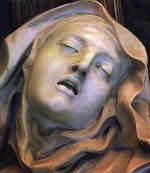Mysticism in the West has always been looked upon with suspicion by Church authorities because premises of mysticism, often not developed or articulated fully, suggested bypassing sacraments, ritual, and dogma in attaining union with God. Western mysticism offered no methodology (a dangerous act had it done so) but the experience itself was probably offensive enough to authorities, the emotional and passionate experience, let alone the subjectivity.
 Bernini captured this dangerous form of expression in his classic portrait of St. Teresa of Avila. Even if he honestly believed this experience a visionary rather than erotic one, who can doubt that the Church would not want it to reflect some goal or norm? Or to have the faithful read lines like these of Teresa:
Bernini captured this dangerous form of expression in his classic portrait of St. Teresa of Avila. Even if he honestly believed this experience a visionary rather than erotic one, who can doubt that the Church would not want it to reflect some goal or norm? Or to have the faithful read lines like these of Teresa:
I saw in his [the angel’s] hand a long spear of gold, and at the iron’s point there seemed to be a little fire. He appeared to me to be thrusting it at times into my heart, and to pierce my very entrails; when he drew it out, he seemed to draw them out also, and to leave me all on fire with a great love of God. The pain was so great, that it made me moan; and yet so surpassing was the sweetness of this excessive pain, that I could not wish to be rid of it. The soul is satisfied now with nothing less than God. The pain is not bodily, but spiritual; though the body has its share in it. It is a caressing of love so sweet which now takes place between the soul and God, that I pray God of His goodness to make him experience it who may think that I am lying. (Autobiography, 29, 17).
How far away from otherwise prosaic voices, from the measured tones of Meister Eckhart to the ruminations of Freud on the pleasure principle versus the reality principle, or phenomenological explorations of Heidegger on openness to mystery. As mentioned in an earlier post, the pleasure principle is the pursuit of excitation, the presumed eros underlying the human psyche that Freud himself came to reject in favor of the reality principle, the underlying trajectory of the psyche for stability, balance, and equanimity.
This divergence is familiar in the East, where popular religion often rides on the crest of ecstasies — as in Rumi or Ramakrishna or Abhishiktananda. Without doubting the authenticity of the experiences or the motives of pursuants, East or West, there is left a begging for credibility mixed with genuine perturbation and a tinge of envy in the lay people who watch as spectators this sport of gods and their chosen ones. Ecstasy becomes a commodity to revive flagging logic and dogged but monotonous asceticism. Ecstasy substitutes for introspection, for self-understanding, a one-time stand that does not prove love but only the pleasure of experience.
Thomas Merton offers wise insight in his Wisdom of the Desert:
Obviously such a path could only be traveled by one who was very alert and very sensitive to the landmarks of a desert wilderness. The hermit had to be a man mature in faith, humble and detached from himself to a degree that is altogether terrible. … The Desert Father could not afford to be an illuminist. He could not dare risk attachment to his own ego, or the dangerous ecstasy of self-will.
No wonder that the hermit, those who are already attracted to solitude, will naturally pursue a path that eschews ecstasy. I am not ready to divest mysticism from mystery, but the wisdom of practice forces consideration of methodology.
A wise voice on navigating practice is a lay person’s: Katsuki Sekida is the author of the invaluable Zen Training: Methods and Philosophy. Sekida distinguishes what we call the ecstatic state (kensho or satori) from a more refined and ongoing state of stillness (samadhi), as his editor A.V. Grimstone points out:
He [Sekida] by no means ignores or belittles kensho, but he does not place it before the student as something he must strive for in his practice of zazen. It is not merely that, like some other writers on Zen, he regards kensho as something that must be allowed to come naturally, in its own time, rather than be sought or induced by artificial methods. For Mr. Sekida the primary, initial aim of zazen is the attainment of the state of absolute samadi: the condition of total stillness, in which “body and mind are fallen off,” no thought stirs, the mind is empty, yet we are in a state of extreme wakefulness. “In this stillness, or emptiness, the source of all kinds of activity is latent. It is this state that we call pure existence.”
Solitude is not merely the condition of physical aloneness nor of psychological alienation but a state of potentiality, wherein the self can work toward self-realization by using the humble and slow techniques or methods of desert hermits and zazen practitioners, among others. The “illuminist” search for ecstasy is not the path of nature, which transforms slowly and leaves room for discovery and reflection long after the excitation of ecstasy has faded into a haunting memory.
